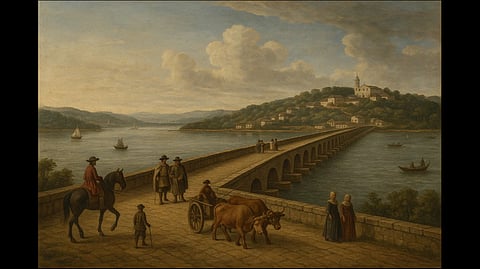

The Ponte de Liñhares, or Ribandar Causeway, built in 1633, remains one of Goa’s most remarkable feats of engineering. Stretching an astonishing 9512 feet, it holds the title of Asia’s longest causeway, linking Panjim with Ribandar. On one side flows the calm River Mandovi, while the other overlooks age-old salt pans nestled in the khazan lands. Unfortunately, rampant vegetation, including mangroves, now threatens this centuries-old heritage structure.
The project was envisioned by Miguel de Noronha, the 4th Count of Linhares and 23rd Viceroy of Portuguese Goa. In the early 1600s, Panjim and Ribandar were divided by a marshy tidal stretch. To strengthen connectivity and transport materials for construction and defense, the Portuguese administration commissioned the Jesuits, who ingeniously used ‘jambho tree’ bark to fortify the soft soil before building the massive masonry causeway.
The structure features 40 arches, primarily on the Panjim side, while the Ribandar-Panjim stretch includes three openings, or ‘manos’, to regulate tidal water into the khazan lands, supporting fish trapping and salt production, an indigenous hydrological system predating the Portuguese.
Though it appears straight, the causeway is actually shaped like an arrow, a clever design that diverts rising tides and monsoon waters sideways toward rivulets at either end. Additional culverts cross the Rua de Ourem and Ribandar creeks, showcasing architectural precision.
Initially built for bullock carts and horse carriages, the Ribandar Causeway remarkably still supports modern heavy traffic nearly four centuries later. Until a few decades ago, even 12–14 wheeled trailers passed over it regularly.
Historically, a two-meter column once stood at the center of the Patto bridge along Rua de Ourem. Set into the column was a basalt stone engraved with the Portuguese coat of arms and an inscription. In the early 1970s, the structure was demolished, likely by nationalists of the time who viewed it as anti-national.
Interestingly, the causeway was constructed at the same time as the Taj Mahal. While work on Ribandar Causeway spanned 1632–1634, construction of the Taj began in 1632 after the death of Mumtaz Mahal. Both masterpieces, standing on the banks of famed rivers, the Mandovi in Goa and the Yamuna in Agra, remain enduring testaments to human craftsmanship and vision.